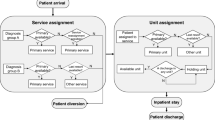Abstract
Over the past several decades healthcare delivery systems have received increased pressure to become more efficient from both a managerial and patient perspective. Many researchers have turned to simulation to analyze the complex systems that exist within hospitals, but surprisingly few have published guidelines on how to analyze models with multiple performance measures. Moreover, the published literature has failed to address ways of analyzing performance along more than one dimension, such as performance by day of the week, patient type, facility, time period, or some combination of these attributes. Despite this void in the literature, understanding performance along these dimensions is critical to understanding the root of operational problems in almost any daily clinic operation. This paper addresses the problem of multiple responses in simulation experiments of outpatient clinics by developing a stratification framework and an evaluation construct by which managers can compare several operationally different outpatient systems across multiple performance measure dimensions. This approach is applied to a discrete-event simulation model of a real-life, large-scale oncology center to evaluate its operational performance as improvement initiatives affecting scheduling practices, process flow, and resource levels are changed. Our results show a reduction in patient wait time and resource overtime across multiple patient classes, facilities, and days of the week. This research has already proven to be successful as certain recommendations have been implemented and have improved the system-wide performance at the oncology center.
Similar content being viewed by others
References
Bailey NTJ (1952) A study of queues and appointment systems in hospital outpatient departments, with special reference to waiting times. J R Stat Soc Ser B 14:185–199
Bailey NTJ (1955) A note on equalising the mean waiting time of successive customers in a finite queue. J R Stat Soc Ser B 17:262–263
White MJ, Blanco MC (1964) Appointment systems in outpatients’ clinics and the effect of patients’ unpunctuality. Med Care 2:133–145
Fetter RB, Thompson JD (1966) Patients’ waiting time and doctors’ idle time in the outpatient setting. Health Serv Res 1:66–90
Soriano A (1966) Comparison of two scheduling systems. Oper Res 14:388–397
Fries BE, Marathe VP (1981) Determination of optimal variable sized multiple block appointment systems. Oper Res 29:324–345
Ho CJ, Lau HS (1992) Minimizing total costs in scheduling outpatient appointments. Manage Sci 38:1750–1764
Jacobson SH, Hall SN, Swisher JR (2006) Discrete-event simulation of health care systems. In: Hall RW (ed.) Patient flow: reducing delay in healthcare delivery. Springer’s International Series in Operations Research & Management Science. Springer, USA
Jun JB, Jacobson SH, Swisher JR (1999) Application of discrete-event simulation in health care clinics: a survey. J Oper Res Soc 50:109–123
England W, Roberts S (1978) Applications of computer simulation in health care. In: Proceedings of the 1978 Winter Simulation Conference 665–676
Babas M, Sarma G (1991) Outpatient queues at the Ibn-Rochd Health Center. J Oper Res Soc 37:845–855
Wilt A, Goddin D (1989) Health care case study: simulating staffing needs and work flow in an outpatient diagnostic center. Ind Eng 21:22–26
Saunders CE, Makens PK, Leblanc LJ (1989) Modeling emergency department operations using advanced computer simulation systems. Ann Emerg Med 18:134–140
Pallin A, Kittell R (1992) Mercy Hospital: simulation techniques for ER processes. Ind Eng 24(2):35–37
Isken M, Ward T, McKee T (1999) Simulating outpatient obstetrical clinics. In: Proceedings of the 1999 Winter Simulation Conference 1557–1563
Vemuri S (1984) Simulated analyses of patient waiting time in an outpatient pharmacy. Am J Hosp Pharm 41:1127–1130
Rising EJ, Baron R, Averill B (1972) A systems analysis of a university health-service outpatient clinic. Oper Res 21:1030–1047
Baesler FF, Sepulveda JA (2001) Multi-objective simulation optimization for a cancer treatment center. In: Proceedings of the 2001 Winter Simulation Conference 1405–1411
Swisher JR, Jacobson SH (2002) Evaluating the design of a family practice healthcare clinic using discrete-event simulation. Health Care Manage Sci 5(2):75–88
Biles WE, Swain JJ (1979) Mathematical programming and the optimization of computer simulations. Math Program Stud 11:189–207
Clayton ER, Weber E, Taylor BW (1982) A goal programming approach to the optimization of multi-response simulation models. IIE Trans 14(4):282–287
Friedman LW (1986) The analysis of multiple response simulation output data: experiments of comparison. Comput Oper Res 13(6):647–652
Montgomery DC, Bettencourt VM (1977) Multiple response surface methods in computer simulation. Simulation 29(4):113–121
Rees L, Clayton ER, Clayton III BW (1984) Solving multiple response simulation models using modified response surface methodology within a lexicographic goal programming framework. IIE Trans 17(1):47–57
Lehaney B, Clarke SA, Paul RJ (1999) A case of an intervention in an outpatients department. J Oper Res Soc 50: 877–891
Cayirli T, Veral E, Rosen H (2006) Designing appointment scheduling systems for ambulatory care services. Health Care Manage Sci 9:47–58
Matta ME (2004) An empirical and theoretical study of outpatient scheduling problems employing simulation and genetic algorithm methodologies. Doctoral Thesis, Department of Business Administration, Duke University, Durham, NC
Author information
Authors and Affiliations
Corresponding author
Rights and permissions
About this article
Cite this article
Matta, M.E., Patterson, S.S. Evaluating multiple performance measures across several dimensions at a multi-facility outpatient center. Health Care Manage Sci 10, 173–194 (2007). https://doi.org/10.1007/s10729-007-9010-2
Received:
Accepted:
Published:
Issue Date:
DOI: https://doi.org/10.1007/s10729-007-9010-2




